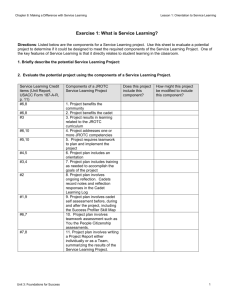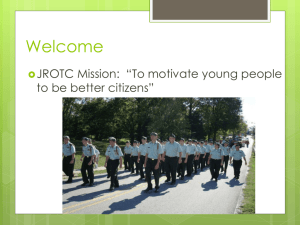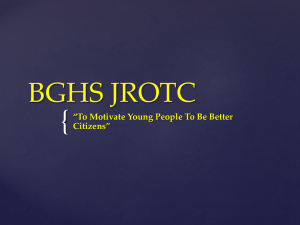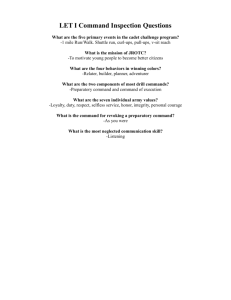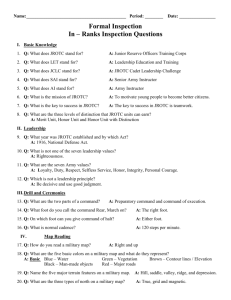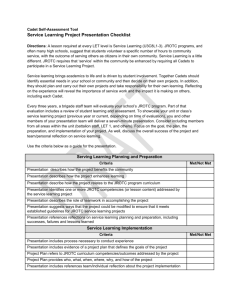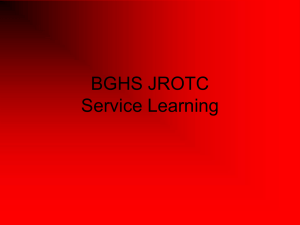Chicago VFP Militarization of Youth PowerPoint
advertisement
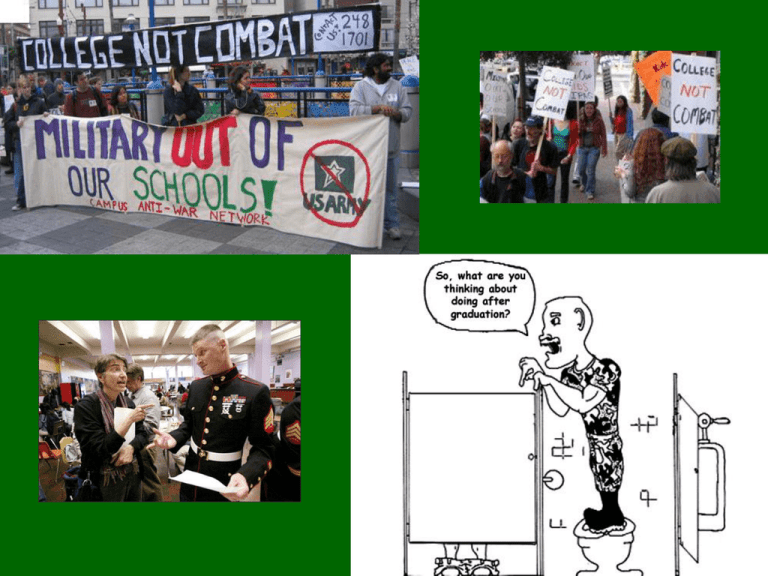
RECRUITMENT BASICS contents • • • • • • • • Introduction to recruitment Reality of the military State of JROTC and Cadet Corps in CPS What is Counter Recruitment What are the issues Background of the Opt-Out form What is ASVAB What you can do WHO ARE RECRUITERS? • Some armed forces personnel volunteer for a recruiting position job and some are chosen to become recruiters • Many don’t want to be recruiters but must to further their career in the military • Most are not out to purposely spread mis-information, they themselves have been indoctrinated and may need to be informed of the issues surrounding what they do • Their performance is measured by how many new recruits they get signed up, not how nice or honest they are • As individuals they are not the enemy, but they should not be welcomed into schools by students, parents or administrators WHY ARE RECRUITERS IN THE SCHOOLS? • The U.S. Army Recruiter Duty Description states : Contacts representatives of schools, public officials, personnel managers, parents of prospective applicants, religious and civil leaders, and others to present the Army as an employment and career opportunity. Presents formal and informal talks on advantages of the Army at civic and service organizations and student bodies. • Schools provide easy, almost unrestricted access to students in their hallways, cafeterias and classrooms • This allows recruitment to begin four years before students will be eligible to join the military • Recruiters, until recently, have faced little or no opposition to their presence in the schools A FEW WAYS RECRUITERS GAIN ACCESS TO YOUTH • SCHOOLS: aside from hallways, cafeterias and classrooms at schools: job fairs, sporting events, school festivals, Cadet Corps in middle schools, JROTC in high schools, ROTC in colleges • MEDIA: school newspapers, tv commercials, movie previews, magazines, billboard advertisements, video games created for the military & downloaded for free from the internet (also collects personal information when registering for download) • CITY SPONSORED EVENTS: Taste of Chicago, Blues Fest, Air & Water Show, Armed Forces Day (Navy Pier), Warped Concert Tour, Puerto Rican Festival and other select neighborhood festivals • MARKETING DATABASE: aside from ASVAB info and school databases required from the No Child Left Behind Act, the Pentagon has recently contracted with a private marketing firm to create a database of ALL high school age students (16-18) & all college students across the country. The new database will contain personal information including birth dates, Social Security numbers, e-mail addresses, grade-point averages, ethnicity and what subjects the students are studying. THE RECRUITING MACHINE • • • • • MARKETING THE MILITARY According to an April 2005 article in the Chicago Tribune: “The military is exhausting every imaginable idea, effort and inducement to keep manpower up and attract qualified troops. Recruiters are hitting NASCAR events, rock concerts, rodeos and rib festivals, using custom-painted Humvees and other gimmicks to attract the masses like old-fashioned traveling salesmen.” The military's recruiting advertising budget doubled from $300 million to nearly $600 million between 1998 and 2003 The overall recruiting budget in 2004 approached 4 billion dollars. A 1.1 million dollar tractor-trailer with an Apache helicopter simulator travels to schools all across America looking for recruits for the Army. Similar trailers contain Humvee simulators The Army video game (America’s Army) itself cost 12 million dollars to develop and is available for free These deceptive marketing techniques reduce the military, war, death & destruction to a mere game WHY YOUTH ENLIST IN THE MILITARY • Money for college • Get away from hostile environments • Lack of jobs • Promise of travel • To heroically serve the country • Family tradition • Discipline and physical challenges • Enlistment bonus up $20,000 REALITY OF THE MILITARY Every enlistment contract contains the following language: Laws and regulations that govern military personnel may change without notice... REGARDLESS of the provisions of this enlistment document. This means the military can change an enlistment contract at any time even if a contract contains written promises. The only benefit of getting recruiter’s promises in writing is that there may be a possibility of discharge if the military breaks the enlistment contract. This however is never a certainty. REALITY OF THE MILITARY The military is rarely best alternative to living in a hostile environment • Drugs, gangs, racism, gender discrimination, bigotry, alcoholism, rape, spousal and child abuse all exist in the military much like it does in the real world or worse depending on the military branch and duty station • The military a dangerous occupation; the likeliness of death or disability due to training or combat related accidents is a valid concern • If an injury is not diagnosed while in the military, the government is not responsible for treating it once the soldier leaves the military • Once out of the military, a veteran could have a myriad of issues to deal with including: Post Traumatic Stress Disorder (PTSD) Delayed Sicknesses such as depleted uranium sickness (DU) Homelessness: one out of every three homeless males has been in the military “Community Homelessness Assessment, Local Education and Networking Group for Veterans, 11 th Annual Progress Report”, May 3, 2005 STATE OF THE JUNIOR RESERVE OFFICERS’ TRAINING CORP (JROTC) IN CHICAGO Message from the director of Chicago JROTC programs We are very proud of our program in Chicago Public Schools. We have the largest JROTC program in the country in number of cadets and total programs. Also, we are unique in offering a myriad of educational opportunities to our students: military academy high schools; military academies within a school; high school JROTC programs; and Middle School Cadet Corps programs. Rick W. Mills Defence Secretary Gen. William Cohen, described JROTC as: “one of the best recruiting services that we could have.” Is Junior ROTC building character -- or lining up soldiers? The military’s success in Chicago has led it to dub the city “the national leader” for integrating JROTC into an urban education system. Chicago has 107 Public High Schools ALL PUBLIC HIGH SCHOOLS IN CHICAGO In Chicago there are: 34 Army JROTC Schools 5 Navy JROTC Schools 2 Marine JROTC Schools 1 Air Force JROTC School 42 Schools with JROTC Programs 3 are full-time military academy high schools JROTC PROGRAMS IN CHICAGO HIGH SCHOOLS CHICAGO HIGH SCHOOLS WITHOUT JROTC ALMOST HALF OF THE CITY’S SCHOOLS HAVE JROTC PROGRAMS Only 5 schools in all of the more affluent Chicago suburbs have JROTC programs The Children’s Crusade, Jennifer Wedekind, June 2005 Chicago currently has 10,600 students enrolled in Junior ROTC programs-and the military plans to increase that number to 15,000 by 2007 The Children’s Crusade, Jennifer Wedekind, June 2005 JROTC costs $75,000 per school The Chicago school system spent $2.8 million on JROTC programs in 2003 and another $5 million on the two military academies -- more than it spends on any other special or magnet program. Nationwide, school districts spend $222 million in tax dollars on JROTC The Children’s Crusade, Jennifer Wedekind, June 2005 “Trading Books for Soldiers; The True Cost of JROTC”, AFSC 2004 “Mayor Daley would like to see JROTC in every classroom,” according to Lt. Col. William Fletcher, deputy director of Chicago’s JROTC program Rick Mills, the JROTC director in Chicago says, “… if we have the opportunity to present ourselves at an earlier age, all the better." MIDDLE SCHOOL CADET CORPS MIDDLE SCHOOL CADET CORPS (MSCC) • 26 MSCC programs in Chicago • 850 students are enlisted • 11 to 14 year old children Herman Barnett, director of Lavizzo’s award-winning MSCC program, asks the public to give the students the benefit of the doubt. “They don’t look at it as getting ready for the army,” he says. “They’re just doing it for entertainment and fun.” INDOCTRINATION (NOT SO) HIDDEN ISSUES BEHIND JROTC • JROTC targets low income communities: the majority of nationwide participants are students of color • JROTC teaches passivity, not leadership or critical thought • JROTC textbooks are biased and bigoted Army JROTC text booklet 3, p. 185, "Fortunately for the Army, the government policy of pushing the Indians farther west then wiping them out was carried out successfully." • JROTC discriminates: against students and instructors who are gay, lesbian or bisexual, people with disabilities and immigrants • schools with JROTC programs, at a very early age, point students towards the military instead of focusing on teaching valid skills that will prepare them for life “All high school students who are .S. citizens at least 14 years or older and are physically fit are eligible to join JROTC”: JROTC Fact Sheet, DOD Public Affairs Office “There is no legal protection for gays and lesbians in the JROTC, only a non-binding commitment from the local JROTC Officer” : Report to San Fransisco School Superintendent Rojas (Sept. 27, 1993) from Mark Barmore, Deputy City Attorney. This is an extension of the Armed Forces stance on homosexuality in the military through the “Don’t Ask Don’t Tell policy. Rick Mills, the director of Military Schools and JROTC for the Chicago Public School system, states: “These kinds of programs would not be in schools if there weren’t kids who wanted it, parents who supported it and administrators who facilitated it.” WHAT IS COUNTER RECRUITMENT • ANY action that stops or hinders military recruitment at any level • EXAMPLES: – GETTING INFORMATION OUT THERE - talking and distributing info to youth, parents, teachers, neighbors & friends about the reality of the military – DEMONSTRATING – in front of recruiting stations, at city festivals where recruiters are present, in parades, at any number of regularly held neighborhood protests – HELPING students, parents and communities get organized around the issues POINT OF COUNTER RECRUITERS “We are not sales people for any ideology or point of view, unlike recruiters, we don’t have quotas to meet. We believe people considering joining the military should be empowered by as much information as possible before making a decision. You should know about the reality of military life and hear the moral arguments against participating in war before making a decision.” CCCO WHAT STUDENTS ARE DOING • letting recruiters in hallways and cafeterias know that they’re not wanted • setting up booths wherever recruiters are, at job fairs and other events, to distribute counter recruitment literature • demanding equal access for classroom speakers who provide information about the military and alternatives to the military • creating alternative displays in the schools to counter military posters and propaganda • organizing to completely ban or severely limit recruiter access to schools January 20, 2005 Students at Seattle Central Community College (CAN) to Recruiters: "No more war, leave our school.“ (NOT SO) HIDDEN ISSUES BEHIND RECRUITMENT • target inner city youth and minority communities • focus their efforts against the poor and working class • rob communities of potential leaders • keeps the cycle of poverty turning (NOT SO) HIDDEN ISSUES OF THE MILITARY • $399 BILLION tax dollars fund the Pentagon • $34 BILLION tax dollars fund K-12 education • 12 TIMES as much money is spent on defense than the education of our country’s youth • the military consists overwhelmingly of the country’s middle & working class; people who are putting their lives in danger in order for the rich of the country to live in extremely comfortable security while taking tax dollars to protect their interests OPT-OUT • vast majority of schools have been voluntarily giving recruiters students’ names, addresses and phone numbers for decades • the No Child Left Behind (NCLB) act of 2001 made providing recruiters access to student lists mandatory • before NCLB, release of the information was discretionary and if schools elected to do it, they had to notify parents of the right to opt out • when NCLB was implemented in 2002 the opt-out right was still in effect, but schools can no longer choose to withhold names, address and phone numbers from recruiters without risking losing their federal funds • opt-out campaigns are important, but they shouldn’t distract from other equally important counter recruitment action • ARMED SERVICES VOCATIONAL APTITUDE BATTERY (ASVAB) • “This program is designed to help students learn more about themselves and the world of work, identify and explore potentially satisfying occupations, and develop an effective strategy to realize their goals.” straight from the ASVAB website • free to schools and targeted for students in grades 10,11,12 & postsecondary schools • 14,000 schools per year administer the ASVAB, taken by 1.25 million students, over half of all high schools nationwide participate • the military gets around the opt-out barrier using the ASVAB • with very few exceptions, the ASVAB results in student contact information and much more personal data being released to recruiters even if opt-out is used • if a school or individual decides to use the ASVAB, they should utilize option 8 ”no release to recruiters”. this option prevents the students' names from being added to the military's recruiting list. be aware however, the military regularly makes absolutely no mention of this option, and often it is purposely left out • schools can also use option 8 to exclude the entire school • students are not required to take the test and can not be forced to give this kind of personal information to the military. unfortunately, some schools give the students the impression that they must take it — or even coerce them into taking it • the ASVAB discriminates against certain groups of people. Many service members are automatically assigned to non-technical military jobs because of poor ASVAB scores. as a result, for example, many African-American service members are assigned to low-skill jobs when they might have been able to be trained for more technical jobs. Women are also less likely to get good scores on the mechanical sections, because many haven't done mechanical work in the past HOW STUDENTS CAN GET INVOLVED • form student social justice clubs look to existing clubs for inspiration • research and learn the facts – there is a wealth of information available from a multitude of sources • learn & know your rights as an individual & student • talk to friends and family to get them involved • perform direct action: confront recruiters, start opt-out & anti-ASVAB campaigns, demonstrate, protest, create new ways of approaching the issues HOW PARENTS CAN GET INVOLVED • talk to teachers, faculty, administrators and guidance counselors • attend/join PTA & school councils • learn the facts about military recruitment and JROTC programs in your child’s school • volunteer to give presentations to schools • indirectly help students organize by offering support and encouragement • understand the need to allow students to act independently • create a parents for social justice group • inform students about their options instead of joining the military (very important) HOW COMMUNITIES CAN GET INVOLVED • resist attempts to militarize schools • demand tax dollars be spent on education, not militarization • support local teacher, student & parent social justice causes & organizations • volunteer support and resources • make yourselves visible & affective • get alderpersons and other local officials involved and aware of local opposition to the militarization of schools and youth • network with other communities interested in the issues of militarization • if one doesn’t already exist, start your own community counter recruitment organization EMPOWER OTHERS BY EMPOWERING YOURSELVES “Counter-recruitment is far more than a tactical issue concerning Iraq. It is an integral part of a larger strategy for defeating militarism that is absolutely necessary to cultivate a political and social climate that embraces critical thinking and democratic discourse. Counter-recruitment work is really an effort to ensure our future ability to work for progressive social change in the U.S. It's very crucial that this larger context not escape us.” Rick Jahnkow 2005
